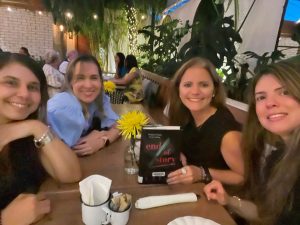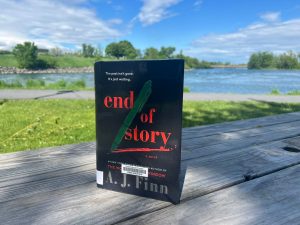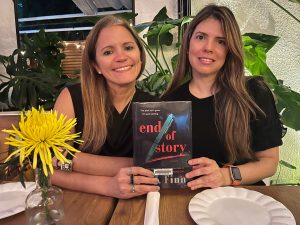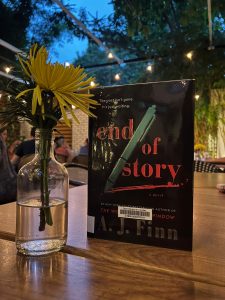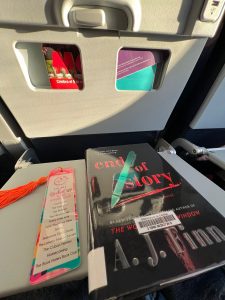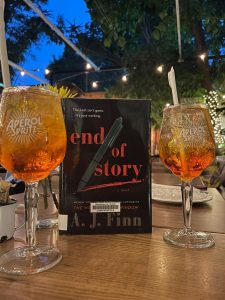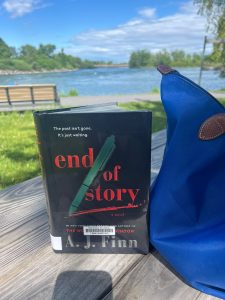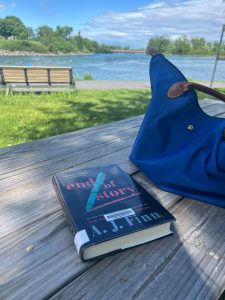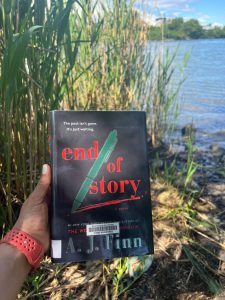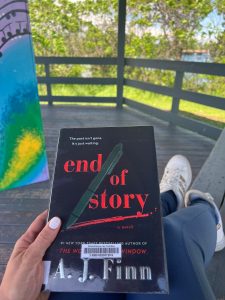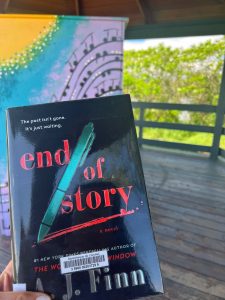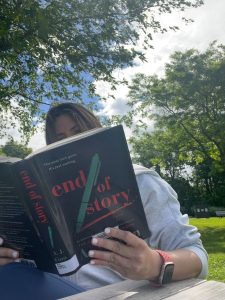
End of Story
“I’ll be dead in three months. Come tell my story.”
So writes Sebastian Trapp, reclusive mystery novelist, to his longtime correspondent Nicky Hunter, an expert in detective fiction. With mere months to live, Trapp invites Nicky to his spectacular San Francisco mansion to help draft his life story . . . living alongside his beautiful second wife, Diana; his wayward nephew, Freddy; and his protective daughter, Madeleine. Soon Nicky finds herself caught in an irresistible case of real-life “detective fever.”
“You and I might even solve an old mystery or two.”
Twenty years earlier—on New Year’s Eve 1999—Sebastian’s first wife and teenaged son vanished from different locations, never to be seen again. Did the perfect crime writer commit the perfect crime? And why has he emerged from seclusion, two decades later, to allow a stranger to dig into his past?
“Life is hard. After all, it kills you.”
As Nicky attempts to weave together the strands of Sebastian’s life, she becomes obsessed with discovering the truth . . . while Madeleine begins to question what her beloved father might actually know about that long-ago night. And when a corpse appears in the family’s koi pond, both women are shocked to find that the past isn’t gone—it’s just waiting.


Daniel Mallory
is an American author who writes crime fiction under the name A. J. Finn. His 2018 novel The Woman in the Window debuted at number one on the New York Times Best Seller list. The Woman in the Window was adapted into a feature film of the same name, directed by Joe Wright and featuring Amy Adams, Julianne Moore and Gary Oldman.
In 2019 an article in the The New Yorker stated that Mallory had frequently lied about his personal life and health. Mallory obliquely acknowledged being deceptive in a statement. Mallory attributed his actions to his struggles with bipolar depressive disorder, which drew criticism from psychiatrists. His second novel, End of Story, was published in February 2024.
I have mixed feelings about this book. I’ve never come across a book so tangled and confusing. The truth is that the story lacks depth and is ambiguous. The author aimed to create something impactful, but it turned out to be a mess.
Plot Summary
The End of Story opens as Nicky Hunter, a detective-fiction expert, arrives at the Trapp mansion in San Francisco to write the memoirs of the famous but infamous author, Sebastian Trapp. Sebastian is rumored to have murdered his first wife, Hope, and their son, Cole, 20 years ago. Hope and Cole vanished on New Year’s Eve, a mystery that was never solved.
Unraveling the Trapp Family
Nicky is greeted by Sebastian’s second wife, Diana, and soon meets his disturbed daughter, Madeleine, and his nervous nephew, Freddy. As Nicky researches the 20-year-old disappearance, she finds Cole’s diary revealing severe bullying and his dislike of himself. She learns that Hope and Cole had an inside joke, “Cherchez la Femme,” which begins appearing as threatening origami butterflies left by someone claiming to be Cole.
The family appears to be unraveling: Diana is grieving the loss of her own first husband and child; Freddy is broadcasting a podcast about the Trapp mystery; and Madeleine is texting “Cole,” who tells her to keep Nicky close. Nicky begins to suspect Freddy, especially after he is unmasked as the perpetrator behind a prank at the Trapp’s Midsummer party.
Death, Confession, and Revelation
The mystery intensifies when Diana is found dead in the koi pond the morning after the party, despite a suicide note. Nicky is urged by Sebastian to stay and solve the new murder. Through more digging, Nicky learns that Diana, who recognized the “Cherchez la Femme” necklace Madeleine was wearing, must have realized something terrible happened to Hope.
Sebastian, convinced the truth is about to be exposed, attempts to end his treatments and writes a letter to Nicky, confessing to killing his first wife and son. Nicky and Detective Martinez track Sebastian and Madeleine to the rock maze by the ocean. As Sebastian prepares to shoot himself, a violent confrontation ensues.
The full, shocking truth is revealed: Nicky is Cole. She is a trans woman who, at 16, told her mother, Hope, that she didn’t belong in her boy’s body. Hope had planned to help her transition and escape to Seattle.
The truth about Hope’s disappearance comes from Madeleine, who confesses that she killed Hope by accident, pushing her during an angry confrontation. Diana had recognized the necklace from an old home movie and confronted Sebastian. Sebastian killed Diana to protect Madeleine. Sebastian gives Nicky a final manuscript—the final novel in his series—before shooting himself. Nicky, surviving her traumatic past, accepts Madeleine’s apology and begins to read her father’s final work.
Character Analysis
Nicky Hunter / Cole Trapp
is a central protagonist and the most successful expression of The Power of Purposeful Reinvention. She is a young professor and expert in detective fiction who is revealed to be the missing son, Cole Trapp, who transitioned after leaving his family. Her deep knowledge of the mystery genre rivals Sebastian’s, allowing her to challenge him on his own turf. Nicky is characterized by a powerful mix of courage and compassion; she is kind and open, easily earning trust, but she is also physically capable—a practiced boxer who won’t hesitate to use force to defend herself and others. Her successful self-reconstruction is the bright counterpoint to the Trapp family’s years of stagnation and secrecy.
Madeleine Trapp
is the second protagonist and Cole’s older sister, whose life has been consumed by a tragic secret. She accidentally killed her mother, Hope, years ago but has never confessed, leading to a life of stagnation and guilt. She lives in the family mansion, perpetually stunted in her ambition and unable to move on. Madeleine’s character highlights The Importance of Support During Psychological Struggle; her lack of support after the tragedy has caused her to feel she must atone by staying with her father. She is torn between resentment and affection for Nicky but ultimately trusts her as the only person she can communicate with as Cole. Her climactic confession is one of the novel’s biggest reveals, freeing her from her long-held secret.
Sebastian Trapp
is the charismatic, bestselling mystery novelist and the subject of the unsolved disappearance of his first wife and son. He is the novel’s tormented, complex figure, now facing kidney failure. Sebastian’s cruelty toward his son, Cole, stemmed from his fear and misunderstanding of Cole’s difference. Recognizing Nicky as his estranged son, he invites her to write his memoirs as a final attempt to connect before his death. Their shared passion for crime fiction becomes a tool for intimacy and understanding. Sebastian spends his life battling a similar suicidal urge as his father and ultimately kills himself in the maze where Cole was conceived.
Diana Trapp
is Sebastian’s beautiful second wife, a quiet, modest woman grieving the loss of her first husband and unborn child. She married Sebastian because they shared a deep, unending grief. Her character highlights the family’s pervasive web of secrets. Her increasing awareness of the family’s toxic dynamics leads to her death. When she recognizes the “Cherchez la Femme” necklace and confronts Sebastian, he kills her to protect Madeleine, making Diana a tragic casualty of the family’s past crimes.
Freddy Trapp
is Sebastian’s nephew and Cole’s only childhood friend. He is an emotionally fragile character whose substance use disorder and history of neglect by his own family have led to a life of disrespect and failure. Out of guilt for not defending Cole and driven by a need for attention, Freddy sells Trapp family memorabilia online, adopting the mask of his uncle’s fictional villain. Freddy is a warning to Nicky, symbolizing how remaining too close to the toxic Trapp family can slowly drain away one’s hope and potential.
Symbols & Motifs
San Francisco 🌉
The city of San Francisco serves as a powerful motif, establishing a mood of mystery, suspense, and instability. The city’s weather and nature—such as fog obscuring characters’ vision and dramatic thunderstorms—mimic the characters’ inability to see the truth and the internal emotional turmoil they face. Iconic landmarks like the Golden Gate Bridge and Chinatown are used not just for setting, but to create literal and symbolic obstacles for the protagonist, Nicky. The image of Nicky concealing herself in the fog near a dragon’s mouth symbolizes her need to obscure her true identity while pursuing the truth in a city associated with crime. By evoking the mood of classic print and film detectives (like Sam Spade) and real-life criminals (like the Zodiac Killer), the city comes “pre-loaded” with suspense, reinforcing the novel’s thriller genre.
Cherchez La Femme
The French phrase “cherchez la femme” (“look for the woman”) is a recurring motif that adds psychological complexity and drives the central plot twist.
Literal Search: It first represents the literal search for the missing mother, Hope Trapp.
Private Code: It was a private joke between Hope and her son, Cole, signifying Cole’s emotional dependence on his mother, which his father misunderstood. The phrase written on the first origami butterfly is a key element of the rising suspense.
The Clue: The phrase is elevated to a crucial clue when the necklace bearing the inscription is found, instructing any searchers to look for the female killer, Madeleine. This plays on the traditional mystery trope where the “woman at the center of the crime” is the culprit or the motive.
Final Revelation: The motif’s deepest meaning is revealed at the end: the family was searching for a man (Cole) when they should have been searching for a woman (Nicky/Cole), underscoring their failure to see the person right in front of them.
Butterflies 🦋
Butterflies are a potent symbol of transformation and The Power of Purposeful Reinvention. Sebastian keeps rare, pinned specimens under the glass of his writing desk, and they are Cole’s chosen origami shape. Cole’s practice of this “transformative artform” foreshadows his own transition into Nicky.
Rejection: Sebastian’s violent burning of Cole’s origami butterflies symbolizes his absolute rejection of his son’s need to transform, marking a turning point that spurs Hope and Cole’s plan to escape.
Imprisonment: The pinned butterflies under Sebastian’s desk represent Cole’s feeling of being trapped in his current state, wings spread wide “in surrender,” before he could leave and transform into Nicky.
Connection and Rebirth: The origami butterflies Nicky sends to Sebastian mark her initial communication and are an early indicator of the transformation Cole has undergone to become Nicky. The butterflies under Sebastian’s desk also hint that he understands the personal significance of this symbol of rebirth more than he lets on.

Iron Flame - Empyrean Series 2

The Fury
You May Also Like

The Wilds – Elin goes to Portugal on a “real vacation”
August 5, 2024
Iron Flame – Empyrean Series 2
June 19, 2024

